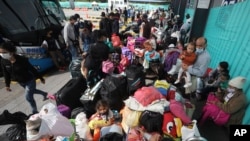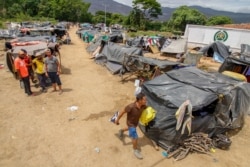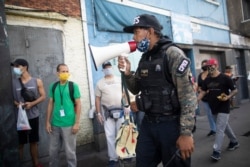Ada Gutierrez has thought about returning to Venezuela every single day since Colombia went into quarantine in late March.
Gutierrez, one of 5 million people who have fled crisis-stricken Venezuela, has spent months of quarantine in Colombia selling candy on the streets of Medellín, the country’s second biggest city.
If she is lucky, she can scrape together enough money each night for her and her and her 18-month-old daughter to split a hotel room with other Venezuelan families. If not, the two sleep on the streets.
“Just like all the Venezuelans around here, we have slept on the street,” she said, outside a station delivering parcels of food to migrants.
“If we have to, we do not eat for the entire day to pay for our room. Our reality here is living day-to-day, sleeping in the streets and going hungry,” said Gutierrez.
Life in limbo
As Latin America emerged as the epicenter of the pandemic, Gutierrez said she wants to return home to Venezuela just as 81,000 other Venezuelans had done by the end of June, according to Colombia’s border control agency.
Gutierrez is among 30,000 Venezuelans that Colombian authorities say are in limbo on the Colombian side of the border.
Their choice is stay in Colombia and struggle to survive through the lockdown or go home to a situation of uncertainty.
At the beginning of the pandemic, migrants walked hundreds of miles back to the Venezuelan border. Others returned by buses facilitated by Colombia, the biggest receiver of the exodus – now eager to send them home.
When they arrive at the border, migrants describe a brutal, sometimes months-long process before they can return home, packed into facilities by Venezuelan authorities with hundreds of other migrants, sleeping on cement floors and often eating little more than undercooked eggs and corn cakes known as arepas.
Fear
The return would be too harsh for her baby, Eva, to go through, Gutierrez said. Other vulnerable populations – families, the elderly, and migrants living with disabilities or medical conditions – have echoed Gutierrez’ fears.
So day after day, she has opted to stay, hoping that at the end of the day, she and Eva will have food, a place to sleep and enough luck to not get infected.
In recent weeks, the Venezuelan government has placed a limit on migrants crossing back to Venezuela, only letting 400 of its citizens cross the land border three times a week.
This comes despite President Nicolas Maduro’s calls for Venezuelans to return home at the beginning of the pandemic, announcing over state television that returnees would be treated with “love and affection.”
Now, more than 30,000 migrants are stuck waiting in Colombia alone, many in makeshift camps in big cities like Medellín and Bogota. The Colombian government said that the process to return could now take up to 6 months.
As cases jump across the region, aid providers like Arles Pereda, president of COLVENZ, the Colony of Venezuelans in Colombia nonprofit group, warn that those camps could become hotbeds for contagion.
“There is a very, very high possibility of an outbreak,” Pereda said. “We have had a lot of luck because that still has not happened,” he said. but it has been very tense because with this invisible enemy, we do not know when it is going to attack.”
Pereda’s organization once provided a safety net to migrants arriving to Medellín. Now, they distribute boxes of food to families starving in months of quarantine and try to connect Venezuelans wanting to return with local governments.
COVID-19 time bomb
Despite low testing rates, Colombia has reported 150,445 confirmed cases and 5,634 deaths as of July 14. Venezuela has reported 9,707 cases and 93 deaths, but observers say the Maduro government is drastically undercounting cases.
In a Reuters interview last month, Colombian President Iván Duque described Venezuela as public health “time bomb.”
The exodus from Venezuela has ballooned in recent years as the South American country’s economic and political spiral accelerates, compounding its medical and energy crises. In a report last year, the Council on Foreign Relations said 3.3 million Venezuelans – 10% of Venezuela’s population - had fled in a four-year period starting in 2015.
Gutierrez left two years ago to give birth to her daughter in Colombia because Venezuelan hospitals were already collapsed and maternal and infant mortalities have skyrocketed.
The mass-migration to countries like Colombia, Peru, Ecuador, and Chile is set to surpass Syria’s as the biggest migration in the world, yet Venezuelan migrants only receive pennies on the dollar in international aid compared to their Syrian counterparts.
Pereda and Gimena Sanchez, Andes director for the Washington Office on Latin America, WOLA, say resources were already insufficient before the pandemic hit. The needs are only heightened as migrants lose their jobs, are kicked out of their homes and face rising xenophobia.
Sanchez said the pandemic is likely to transform the exodus and leave more migrants like the Gutierrez family vulnerable.
Exodus changing direction
“They cannot transit like they used to,” she said. “What you are going to see is more and more people becoming stuck or going back-and-forth.”
While Colombia was once largely a transit country, regional restrictions and instability will push migrants to increasingly stay on Colombian territory, she said. As the crisis stretches on, Sanchez said there will be more of an ebb-and-flow from Venezuela as waves of crises strike, turning migration from a one-directional exodus to more of a pendulum of flows between the two countries.
That could be devastating for Colombia, which is still struggling to emerge from decades of an internal conflict that already displaced nearly 8 million of its own citizens.
Gutierrez takes it one day at time. As she sees it, she has no other choice.
“I'm scared, but I have to go out to the streets every single day and search for a way to feed ourselves,” she said, “because that's how we stay alive.”










